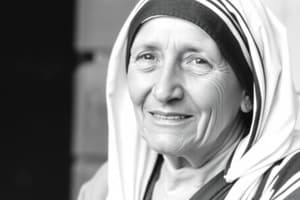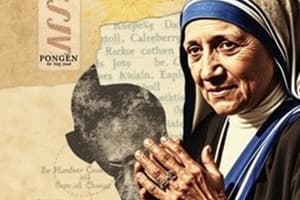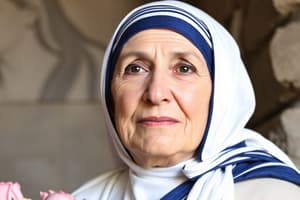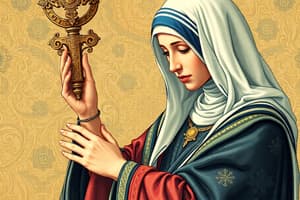Podcast
Questions and Answers
What key message about holiness did Robert Lax communicate to Thomas Merton, influencing Mother Teresa's life work?
What key message about holiness did Robert Lax communicate to Thomas Merton, influencing Mother Teresa's life work?
- Holiness is achieved through rigorous self-denial and ascetic practices.
- Holiness is primarily about performing grand gestures of charity.
- Holiness centers on desiring it and persistently striving for it. (correct)
- Holiness is intrinsically linked to a life of solitude and contemplation.
How did Mother Teresa's physical appearance notably change after she became a nun?
How did Mother Teresa's physical appearance notably change after she became a nun?
- She developed a more robust physique due to the demands of her work.
- Her skin tone lightened as a result of spending less time outdoors.
- She adopted simple attire that concealed her hair and forehead. (correct)
- Her eyes became more vibrant and expressive, reflecting her inner joy.
What constant and defining physical characteristic was noted about Mother Teresa throughout her life?
What constant and defining physical characteristic was noted about Mother Teresa throughout her life?
- Her strong hands, reflecting the manual labor she undertook daily.
- Her eyes, reflecting both joy and suffering. (correct)
- Her warm smile that radiated compassion and understanding.
- Her height and slender frame, which made her stand out in crowds.
What was Pope John Paul II's initial stance regarding the calls for Mother Teresa's canonization?
What was Pope John Paul II's initial stance regarding the calls for Mother Teresa's canonization?
What belief did Mother Teresa consider essential for sustaining love in action?
What belief did Mother Teresa consider essential for sustaining love in action?
According to Mother Teresa, what constitutes the foundational step toward achieving holiness?
According to Mother Teresa, what constitutes the foundational step toward achieving holiness?
What practice from her time with the Loreto Sisters did Mother Teresa maintain even after establishing her own order?
What practice from her time with the Loreto Sisters did Mother Teresa maintain even after establishing her own order?
What phrase did Mother Teresa often use to define her sense of humility in carrying out her mission?
What phrase did Mother Teresa often use to define her sense of humility in carrying out her mission?
Why did Mother Teresa consider 'accepting humiliations' a vital component of holiness?
Why did Mother Teresa consider 'accepting humiliations' a vital component of holiness?
What revelation during Thomas Merton’s experience in Louisville reflects a sentiment shared by Mother Teresa?
What revelation during Thomas Merton’s experience in Louisville reflects a sentiment shared by Mother Teresa?
What major political event coincided with Mother Teresa's birth?
What major political event coincided with Mother Teresa's birth?
What were the circumstances surrounding the death of Mother Teresa's father?
What were the circumstances surrounding the death of Mother Teresa's father?
What crucial lesson regarding food did Mother Teresa's mother consistently teach her children?
What crucial lesson regarding food did Mother Teresa's mother consistently teach her children?
As a young girl, what instrument did Anjezë (Mother Teresa) play, reflecting her upbringing?
As a young girl, what instrument did Anjezë (Mother Teresa) play, reflecting her upbringing?
What specific annual event significantly influenced Mother Teresa's early calling to religious life?
What specific annual event significantly influenced Mother Teresa's early calling to religious life?
How did Mother Teresa's brother, Lazar, initially perceive her growing devotion to religious life?
How did Mother Teresa's brother, Lazar, initially perceive her growing devotion to religious life?
What particular Jesuit spiritual practice had a profound influence on young Anjezë?
What particular Jesuit spiritual practice had a profound influence on young Anjezë?
What major global event during Anjezë's teenage years significantly impacted her perspective?
What major global event during Anjezë's teenage years significantly impacted her perspective?
Why did Mother Teresa's mother initially express reservation about her daughter's religious calling?
Why did Mother Teresa's mother initially express reservation about her daughter's religious calling?
What early talent did Mother Teresa demonstrate as a young girl, hinting at her future communication abilities?
What early talent did Mother Teresa demonstrate as a young girl, hinting at her future communication abilities?
What motivated young Anjezë’s strong desire to go to India?
What motivated young Anjezë’s strong desire to go to India?
Upon arriving at the Loreto Abbey in Dublin, what primary challenge did Mother Teresa face?
Upon arriving at the Loreto Abbey in Dublin, what primary challenge did Mother Teresa face?
How did Mother Teresa react upon witnessing extreme poverty in India for the first time?
How did Mother Teresa react upon witnessing extreme poverty in India for the first time?
What was Mother Teresa's initial role or assignment in India?
What was Mother Teresa's initial role or assignment in India?
Why did Anjezë choose to change her name to Teresa?
Why did Anjezë choose to change her name to Teresa?
What specific skill earned Mother Teresa the nickname 'Bengali Teresa'?
What specific skill earned Mother Teresa the nickname 'Bengali Teresa'?
How did working at St. Teresa's school deepen Mother Teresa's understanding of poverty?
How did working at St. Teresa's school deepen Mother Teresa's understanding of poverty?
What wartime experience led to Mother Teresa taking on a leadership role?
What wartime experience led to Mother Teresa taking on a leadership role?
What personal vow did Mother Teresa make during the hardships of wartime?
What personal vow did Mother Teresa make during the hardships of wartime?
Which traumatic event in 1946 significantly impacted Mother Teresa and marked her 'call within a call'?
Which traumatic event in 1946 significantly impacted Mother Teresa and marked her 'call within a call'?
What event that occurred on September 10, 1946, is annually commemorated by the Missionaries of Charity?
What event that occurred on September 10, 1946, is annually commemorated by the Missionaries of Charity?
What physical obstacle defined Mother Teresa's journey to Darjeeling when she received her calling?
What physical obstacle defined Mother Teresa's journey to Darjeeling when she received her calling?
What was distinctive about Mother Teresa's account of her second calling?
What was distinctive about Mother Teresa's account of her second calling?
What phrase from the Bible did Mother Teresa focus on during her retreat after receiving her call?
What phrase from the Bible did Mother Teresa focus on during her retreat after receiving her call?
Where was the phrase "I thirst" displayed in Missionaries of Charity chapels, and what did it signify?
Where was the phrase "I thirst" displayed in Missionaries of Charity chapels, and what did it signify?
What was revealed in the "Varanasi Letter" of March 1993 regarding Mother Teresa's experience of her call?
What was revealed in the "Varanasi Letter" of March 1993 regarding Mother Teresa's experience of her call?
What affectionate terms did Jesus use to address Mother Teresa in her interior locutions?
What affectionate terms did Jesus use to address Mother Teresa in her interior locutions?
During her prayer, what deeper insight did Mother Teresa gain into Jesus' words "I thirst"?
During her prayer, what deeper insight did Mother Teresa gain into Jesus' words "I thirst"?
Flashcards
Lax's view on holiness?
Lax's view on holiness?
Holiness is about desiring and striving to be a saint.
Mother Teresa's pre-nun features?
Mother Teresa's pre-nun features?
She had thick, dark hair and a high, graceful forehead.
Defining physical trait
Defining physical trait
Eyes reflecting joy and suffering.
Pope's initial reaction?
Pope's initial reaction?
Signup and view all the flashcards
Key to love in action?
Key to love in action?
Signup and view all the flashcards
First step to holiness?
First step to holiness?
Signup and view all the flashcards
Lasting Loreto Habit
Lasting Loreto Habit
Signup and view all the flashcards
Phrase on Humility
Phrase on Humility
Signup and view all the flashcards
Accepting Humiliations
Accepting Humiliations
Signup and view all the flashcards
Merton's epiphany
Merton's epiphany
Signup and view all the flashcards
Political conflict at birth?
Political conflict at birth?
Signup and view all the flashcards
Father's Death?
Father's Death?
Signup and view all the flashcards
Lesson Regarding food?
Lesson Regarding food?
Signup and view all the flashcards
Anjezë's first instrument?
Anjezë's first instrument?
Signup and view all the flashcards
Influential pilgrimage?
Influential pilgrimage?
Signup and view all the flashcards
Lazar's reaction?
Lazar's reaction?
Signup and view all the flashcards
Jesuit practice?
Jesuit practice?
Signup and view all the flashcards
Major World event?
Major World event?
Signup and view all the flashcards
Mother's hesitation?
Mother's hesitation?
Signup and view all the flashcards
Literary talent?
Literary talent?
Signup and view all the flashcards
Attraction to India?
Attraction to India?
Signup and view all the flashcards
Biggest challenge in Dublin?
Biggest challenge in Dublin?
Signup and view all the flashcards
Response to poverty?
Response to poverty?
Signup and view all the flashcards
First assignment in India?
First assignment in India?
Signup and view all the flashcards
Name's saint?
Name's saint?
Signup and view all the flashcards
"Bengali Teresa"?
"Bengali Teresa"?
Signup and view all the flashcards
Poverty deepens?
Poverty deepens?
Signup and view all the flashcards
Wartime leadership
Wartime leadership
Signup and view all the flashcards
Vow in wartime?
Vow in wartime?
Signup and view all the flashcards
"Call within a call"?
"Call within a call"?
Signup and view all the flashcards
Event Commemorated?
Event Commemorated?
Signup and view all the flashcards
Physical challenge?
Physical challenge?
Signup and view all the flashcards
Second calling?
Second calling?
Signup and view all the flashcards
Bible phrase after call?
Bible phrase after call?
Signup and view all the flashcards
"I thirst" displayed?
"I thirst" displayed?
Signup and view all the flashcards
Varanasi Letter?
Varanasi Letter?
Signup and view all the flashcards
Personal Titles?
Personal Titles?
Signup and view all the flashcards
"I thirst" deeper?
"I thirst" deeper?
Signup and view all the flashcards
Emotion Expressed?
Emotion Expressed?
Signup and view all the flashcards
Symbolic Act?
Symbolic Act?
Signup and view all the flashcards
Study Notes
- Robert Lax told Thomas Merton that holiness is about desiring to be a saint and striving for it.
- After becoming a nun, Mother Teresa's thick, dark hair and high, graceful forehead were hidden behind a veil.
- Mother Teresa's eyes reflected both sheer joy and intolerable suffering throughout her life.
- Pope John Paul II was initially reluctant to speed up Mother Teresa's canonization but later agreed due to his admiration for her.
- Mother Teresa believed seeing Christ in everyone was essential to sustaining love in action.
- Self-emptying and surrendering to God's will, or "downward mobility" was emphasized as the first step to holiness.
- Mother Teresa continued the Loreto Sisters' habit of daily Eucharistic adoration and early morning prayers even after founding her own order.
- Mother Teresa often repeated, "I will, I want, with God's blessing, to be holy." to describe her humility.
- Mother Teresa considered accepting humiliations an essential part of holiness because it allowed one to let go of bitterness and ego.
- Thomas Merton's epiphany about love, aligning with Mother Teresa’s beliefs came while standing on a street corner in Louisville, where he felt an overwhelming love for humanity and realized everyone is "walking around shining like the sun".
A Skopje Childhood
- The Ottoman Empire was crumbling, and Kosovo Albanians were unsuccessfully revolting for independence at the time of Mother Teresa's birth.
- Mother Teresa's father was suspected to have been poisoned by Serbian nationalists for his political activism.
- Mother Teresa's mother taught her children never to eat a single mouthful unless they shared it with others.
- Anjezë's first instrument was the mandolin, reflecting her family's musical background and devotion to religious expression.
- The annual pilgrimage to Our Lady of the Black Mountain in Letnica influenced Mother Teresa's vocation.
- Her brother Lazar found her increasing piety excessive, stating his mother and sisters "lived as much in the church as they did at home".
- The Ignatian exercises, including daily examination of conscience and placing oneself in biblical scenes, deeply influenced young Anjezë.
- World War I destabilized the Balkans and contributed to regional poverty during her teenage years.
- Her mother hesitated to support her religious calling at first, fearing Anjezë's frail health would not withstand the rigorous life of a nun.
- She wrote articles for the local newspaper as a young girl.
Loreto – The Missionary Calling
- She felt a strong attraction to India after reading letters from Jesuit missionaries detailing their experiences.
- Her biggest challenge was learning English from scratch in just six weeks when she arrived at the Loreto Abbey in Dublin.
- She was shocked by the suffering she witnessed in Madras, shattering any romantic notions of missionary work, when first responding to extreme poverty.
- She was sent to St. Mary's in Calcutta, where she taught history and geography for her first assignment in India.
- She changed her name from Anjezë to Teresa in honor of St. Thérèse of Lisieux, her spiritual role model.
- Her fluency in Bengali earned her the nickname "Bengali Teresa", learning it while mastering English.
- She realized that hunger and illness prevented learning, leading her to visit slum residents on Sundays, deepening her understanding of poverty.
- She became the acting principal of a makeshift school for displaced children during World War II and this wartime experience forced her into leadership.
- She vowed to give God anything He asked in April 1942, binding under mortal sin.
- Witnessing the Direct Action Day riots in 1946 marked her "call within a call", and she felt the suffering of the poor more acutely.
The Call Within a Call
- September 10, 1946 is commemorated annually by the Missionaries of Charity as "Inspiration Day," after Mother Teresa experienced her "call within a call".
- The main physical challenge in her journey to Darjeeling was the arduous journey, involving a transfer at Siliguri to the "Toy Train", which had to make a steep 64-kilometer climb to Darjeeling, often delayed by mechanical breakdowns or heat-warped rails.
- Her second calling was not a supernatural experience, but an absolute conviction in "quiet, intimate prayer" that Jesus was calling her to a new mission.
- Mother Teresa meditated on the phrase "I thirst"—the words of Jesus to the Samaritan woman at the well and on the cross, believing it symbolized Christ's thirst for love and for serving the suffering.
- The phrase "I thirst" was inscribed prominently near the altar in every Missionaries of Charity chapel to emphasize the belief that Jesus' thirst for love extended to the poor and abandoned.
- New details were written in the "Varanasi Letter" from March 1993, where she admitted she had kept this experience private for decades, stating, "Jesus' thirst is something so intimate... I have felt shy until now to speak of it."
- He called her "My own spouse" and "My own little one," in His interior locutions reinforcing the deeply personal nature of her mission.
- She realized during her prayer that Christ's thirst was not just physical but a longing for love and companionship mirroring the isolation and suffering of the poor.
- She feared being seen as "a fool, proud, or mad" and struggled with leaving the security of her order as she first considered leaving the Loreto Sisters.
- She removed her Loreto habit, replaced it with a simple white sari with blue stripes, and quietly walked away from the convent, stepping into the unknown for her transition from the Loreto Sisters to her new calling.
Early Days
- Archbishop Périer's main concern was that her efforts to serve the poorest of the poor would either fail or cause her to burn out since most missionaries targeted the educated middle class.
- The area of Motijhil was called "pearl lake" because of a polluted horseshoe-shaped body of water that surrounded the slum.
- She empathized with the poor who had to walk everywhere, feeling the same physical exhaustion she endured in search of food, shelter, and work, realizing this after walking long distances daily in her early mission.
- She donated her last rupee to a priest collecting for the Catholic press, and he returned with 50 rupees from a benefactor which was her first financial donation.
- She scratched letters in the dirt with a stick, using the ground as a blackboard for her open-air school as she taught her first classes for children.
- Alfred Gomes, a businessman, offered her a second-floor space, and she made a desk, bookshelf, and altar from discarded wooden crates prompting her move to 14 Creek Lane.
- Subhasini Das, a former student, arrived at her door and said, "Mother, I have come to join you." and later became Sister Agnes.
- Young women faced backlash because they came from middle-class families, and their relatives were ashamed that they were working with untouchables, with some fathers even disowning them.
- She became an Indian citizen and completed her one-year probationary period in 1949, allowing her to apply for Vatican recognition of her work.
- Hindu communities were suspicious that she was converting the dying to Christianity, leading to stone-throwing mobs attacking Nirmal Hriday as the first major opposition she faced.
Manifestly the Finger of God
- Archbishop Périer declared that the expansion of the Missionaries of Charity was "manifestly the finger of God", to acknowledge the success of Mother Teresa's work, despite initial doubts.
- She said, "If there are poor on the moon, we shall go there too," emphasizing her limitless commitment to serving the poor.
- The first international mission was in Venezuela, founded in 1965.
- She required that a bishop or archbishop formally request the Missionaries of Charity before sending Sisters to a new location, to ensure only truly needed missions are established.
- She feared that donors would give money instead of offering personal sacrifices and did not want the order to be burdened by bookkeeping and investments initially resisting regular financial contributions.
- Malcolm Muggeridge, a British journalist, conducted a television interview, leading to a documentary and book titled Something Beautiful for God, in 1968 making Mother Teresa an international celebrity.
- Muggeridge claimed the film developed, despite the dim lighting in Kalighat, as if the room had been bathed in bright light which was attributed to divine illumination.
- Muggeridge was a notoriously skeptical and sharp-tongued journalist, yet he was deeply moved by Mother Teresa and later converted to Christianity which was surprising to those who knew him.
- She realized that some tasks, especially those requiring physical strength and work in dangerous areas, were better suited for men so she founded the Brothers of Charity in 1967.
- She disliked personal attention and was reluctant to talk about herself, but accepted the publicity as necessary for the sake of the mission after the Muggeridge documentary.
Into the World
- The Nobel Peace Prize ensured that reporters constantly surrounded her, religious leaders praised her, and politicians tried to associate with her for public approval, as an unexpected consequence.
- She asked if she could tell bishops that "the Holy Father has forbidden me to go" to avoid too many invitations, as a humorous request to Pope John Paul II.
- When she placed a garland of flowers around his neck, the Pope took it off and placed it around hers, reversing the traditional act of honor, during his visit to Kalighat in 1986.
- He personally commissioned a second mission in Rome to care for the homeless, with the Vatican providing financial support as Pope John Paul II's direct involvement.
- She negotiated a ceasefire so she could rescue 40 developmentally challenged children trapped in a bombed-out building during the Lebanese civil war.
- Her visit drew international attention, forcing both the Indian government and Western nations to provide increased aid, in Bhopal in 1984, regarding the response to the gas leak disaster.
- She traveled to Chernobyl in 1986, providing aid and organizing relief for victims of the nuclear disaster to earn the Soviet Union's Gold Medal of Peace.
- She saw that AIDS patients were socially rejected, feared, and left to die alone, similar to how lepers were treated historically calling AIDS "the new leprosy of the West".
- She personally appealed to New York Governor Mario Cuomo, convincing him to transfer the prisoners to her hospice, to secure the release of three AIDS-infected inmates from Sing Sing prison.
- She called abortion "the worst evil and the greatest enemy of peace", equating it with war and violence in her 1979 Nobel Prize speech.
Love in Action
- A businessman gifted Mother Teresa a personal "calling card", which contained her spiritual philosophy in five steps, called The Simple Path.
- The five steps outlined in Mother Teresa's calling card, The Simple Path, summarized the spiritual journey she and her Missionaries of Charity followed: Silence leads to Prayer, Prayer leads to Faith, Faith leads to Love, Love leads to Service, Service leads to Peace.
- She said, "My vocation is to belong to Jesus, to cleave to Jesus. The work is the fruit of my love and my love is expressed in my work".
- Mary Ward, the 17th-century founder of the Loreto Sisters, who combined contemplative prayer with active service, influenced Mother Teresa's approach to prayer and action.
- She believed it symbolized Christ's longing for love, kindness, and trust, which became the core mission of the Missionaries of Charity interpreting Jesus' words, "I thirst,".
- She told the story of a little robin that saw Jesus suffering on the cross, removed a thorn from his crown, and in doing so pierced itself, sharing in His pain, as the parable to illustrate the sacrifices.
- She believed that the poor deserved dignity and love, and that service done with sadness would only deepen their suffering so she emphasized serving the poor with joy.
- "Seeking the face of God in everything, everyone, everywhere, all the time, and seeing His hand in every happening" was emphasized as recognising God's presence.
- She suffered from spiritual dryness and a lack of sensing God's presence, yet never wavered in her mission personally enduring this.
- She told them to "Do something beautiful for God", emphasizing that even small acts of love, like smiling or carrying a bucket of charcoal, were meaningful in God's eyes advice to those wanting to contribute to her mission.
Saint of Darkness
- She feared that revealing these experiences could cause scandal or detract from the mission of the Missionaries of Charity reluctance to speak publicly about interior locutions.
- The publication of Come Be My Light in 2007 caused controversy, revealing that she suffered a deep sense of God's absence for nearly 50 years.
- Christopher Hitchens claimed that the letters showed her as a "confused old lady" who had lost faith, and argued that the Catholic Church marketed her despair as faith interrperting the revelations.
- The primary torment she expressed was the feeling that God had abandoned her, writing: “The place of God in my soul is blank—There is no God in me."
- She related to the writings of St. John of the Cross, who described the Dark Night of the Soul, and St. Thérèse of Lisieux, who wrote about God's hidden presence during her spiritual darkness.
- She briefly felt a return of God's presence after praying to Pope Pius XII following his death, providing her with temporary relief from spiritual darkness in 1958.
- She believed that her darkness was a way to share in the suffering of Christ, making her mission even more profound so she interpreted her suffering.
Saint Teresa
- She had promised God to never refuse Him anything He asked of her, which led her to embrace even her own spiritual pain, so 1942 may have contributed to her acceptance of suffering.
- She wrote, "I want Jesus," likely referring both to her desire for the Eucharist and her longing to finally feel God's presence again were words while suffering from illness.
- She stated, "If I ever become a saint—l will surely be one of 'darkness'... I will continually be absent from heaven—to light the light of those in darkness on earth" making extraordinary claim about role after death.
- She dreamed that St. Peter denied her entry because there were no slums in heaven and angrily declared that she would return to Earth and fill heaven with the homeless and hopeless.
- She believed that the cost of her medical treatment took away resources from the poor, even attempting to sneak out of a hospital once to avoid treatment reasons for resisting it.
- Her last public statement was a prayer for Princess Diana, who had died just a few days before her. Teresa and Diana had been close friends, having met just two months earlier which are significant.
- A pencil was placed on her coffin symbolizing her belief that she was merely an instrument in God's hand.
- Her body was carried on the same gun carriage used for the funerals of Gandhi and Jawaharlal Nehru which was dedicated to peace.
- A West Bengali woman named Monica Besra was cured of an abdominal tumor after a Sister placed a medal touched to Mother Teresa's body on her stomach and prayed the Memorare confirmed the miracle.
- She declared that if she ever became a saint, she would "continually be absent from heaven" to bring light to those suffering in spiritual darkness on Earth as to believe she would become it.
- He waived the five-year waiting period, allowing it to start in 1999, just two years after her death played in canonization.
- Eulogies were given by representatives of multiple faiths, including Hindu, Muslim, and Sikh leaders highlighted the appeal in christianity.
- A Brazilian man suffering from a deadly brain tumour was healed in 2008 after his family and prayed to intercession to lead to canonization.
Studying That Suits You
Use AI to generate personalized quizzes and flashcards to suit your learning preferences.




